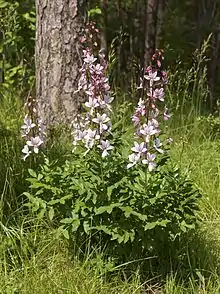Dictamnus
Dictamnus is a monotypic genus of flowering plants in the family Rutaceae. The species, Dictamnus albus, is also known as burning bush,[2] dittany,[2] gas plant[2] or fraxinella.[2] This herbaceous perennial has several geographical variants.[3] It is native to warm, open woodland habitats in southern Europe, north Africa and much of Asia.
| Dictamnus | |
|---|---|
 | |
| Dictamnus albus in flower | |
| Scientific classification | |
| Kingdom: | |
| (unranked): | |
| (unranked): | |
| (unranked): | |
| Order: | |
| Family: | |
| Subfamily: | |
| Genus: | Dictamnus |
| Species: | D. albus |
| Binomial name | |
| Dictamnus albus | |
| Synonyms[1] | |
|
Synonyms list
| |
Description
This plant grows about 40 cm (16 in) to 100 cm (39 in) high. Its flowers form a loose pyramidal spike and vary in colour from pale purple to white. The flowers are five-petalled with long projecting stamens. The leaves resemble those of an ash tree.[3]
Volatile oils
The name "burning bush" derives from the volatile oils produced by the plant, which can catch fire readily in hot weather,[4] leading to comparisons with the burning bush of the Bible, including the suggestion that this is the plant involved there. The daughter of Swedish botanist Carl Linnaeus is said to have ignited the air once, at the end of a particularly hot, windless summer day, above Dictamnus plants, using a simple matchstick. The volatile oils have a reputed component of isoprene.
Cultivation
Several varieties and cultivars have been selected for garden use. The variety D. albus var. purpureus in which the violet-purple is confined to veining of white petals with a slight blush, has gained the Royal Horticultural Society's Award of Garden Merit.[5][6] Dictamnus is tap-rooted, making mature plants difficult to establish and resistant to division; young plants often need three years before they begin to flower, and since it is late to break into leaf in spring, even quite mature clumps may be harmed with vigorous soil-working in spring. For all these reasons, added to toxicity of the foliage, Dictamnus is rarely seen in American gardens.
Toxicity
The leaves have a bitter and unpalatable taste. Despite the lemon-like smell, the plant is acrid when eaten. All parts of the plant may cause mild stomach upset if eaten, and contact with the foliage may cause phytophotodermatitis.[3]
Chemistry
More than 100 chemical constituents have been isolated from the genus Dictamnus, including alkaloids, limonoid triterpenoids, flavonoids, sesquiterpenoids, coumarins, and phenylpropane.[7]
Gallery
 Illustration of Dictamnus albus, from Flora von Deutschland, Österreich und der Schweiz 1885
Illustration of Dictamnus albus, from Flora von Deutschland, Österreich und der Schweiz 1885 Plant of Dictamnus albus purpureus
Plant of Dictamnus albus purpureus Inflorescence of Dictamnus albus purpureus
Inflorescence of Dictamnus albus purpureus Close-up on a flowers of Dictamnus albus purpureus
Close-up on a flowers of Dictamnus albus purpureus Fruit of Dictamnus albus
Fruit of Dictamnus albus Leaves of Dictamnus albus, which give rise to the common name "Fraxinella" ("little ash)"
Leaves of Dictamnus albus, which give rise to the common name "Fraxinella" ("little ash)"
References
- The Plant List: A Working List of All Plant Species, retrieved 23 June 2016
- "Dictamnus albus". Germplasm Resources Information Network (GRIN). Agricultural Research Service (ARS), United States Department of Agriculture (USDA). Retrieved 24 June 2015.
- RHS A-Z encyclopedia of garden plants. United Kingdom: Dorling Kindersley. 2008. p. 1136. ISBN 978-1405332965.
- http://www.missouribotanicalgarden.org/PlantFinder/PlantFinderDetails.aspx?taxonid=286761
- "Dictamnus albus var. purpureus". Royal Horticultural Society. Retrieved 24 July 2013.
- "AGM Plants - Ornamental" (PDF). Royal Horticultural Society. July 2017. p. 29. Retrieved 6 February 2018.
- Gao X.; Zhao P.-H.; Hu J.-F. (2011). "Chemical constituents of plants from the genus Dictamnus". Chemistry and Biodiversity. 8 (7): 1234–1244. doi:10.1002/cbdv.201000132. PMID 21766445.
